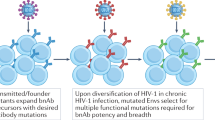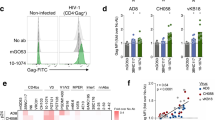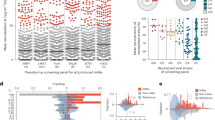Abstract
Broadly neutralizing antibodies (bnAbs) are a focal component of HIV-1 vaccine design, yet basic aspects of their induction remain poorly understood. Here we report on viral, host and disease factors that steer bnAb evolution using the results of a systematic survey in 4,484 HIV-1-infected individuals that identified 239 bnAb inducers. We show that three parameters that reflect the exposure to antigen—viral load, length of untreated infection and viral diversity—independently drive bnAb evolution. Notably, black participants showed significantly (P = 0.0086–0.038) higher rates of bnAb induction than white participants. Neutralization fingerprint analysis, which was used to delineate plasma specificity, identified strong virus subtype dependencies, with higher frequencies of CD4-binding-site bnAbs in infection with subtype B viruses (P = 0.02) and higher frequencies of V2-glycan-specific bnAbs in infection with non–subtype B viruses (P = 1 × 10−5). Thus, key host, disease and viral determinants, including subtype-specific envelope features that determine bnAb specificity, remain to be unraveled and harnessed for bnAb-based vaccine design.
This is a preview of subscription content, access via your institution
Access options
Subscribe to this journal
Receive 12 print issues and online access
$259.00 per year
only $21.58 per issue
Buy this article
- Purchase on SpringerLink
- Instant access to full article PDF
Prices may be subject to local taxes which are calculated during checkout





Similar content being viewed by others
References
Burton, D.R. & Mascola, J.R. Antibody responses to envelope glycoproteins in HIV-1 infection. Nat. Immunol. 16, 571–576 (2015).
Klein, F. et al. Antibodies in HIV-1 vaccine development and therapy. Science 341, 1199–1204 (2013).
Mascola, J.R. & Haynes, B.F. HIV-1 neutralizing antibodies: understanding nature's pathways. Immunol. Rev. 254, 225–244 (2013).
Moore, P.L., Williamson, C. & Morris, L. Virological features associated with the development of broadly neutralizing antibodies to HIV-1. Trends Microbiol. 23, 204–211 (2015).
Caskey, M. et al. Viremia suppressed in HIV-1-infected humans by broadly neutralizing antibody 3BNC117. Nature 522, 487–491 (2015).
Lynch, R.M. et al. Virologic effects of broadly neutralizing antibody VRC01 administration during chronic HIV-1 infection. Sci. Transl. Med. 7, 319ra206 (2015).
Trkola, A. et al. Delay of HIV-1 rebound after cessation of antiretroviral therapy through passive transfer of human neutralizing antibodies. Nat. Med. 11, 615–622 (2005).
Scheid, J.F. et al. HIV-1 antibody 3BNC117 suppresses viral rebound in humans during treatment interruption. Nature 535, 556–560 (2016).
Euler, Z. et al. Longitudinal analysis of early HIV-1-specific neutralizing activity in an elite neutralizer and in five patients who developed cross-reactive neutralizing activity. J. Virol. 86, 2045–2055 (2012).
Simek, M.D. et al. Human immunodeficiency virus type 1 elite neutralizers: individuals with broad and potent neutralizing activity identified by using a high-throughput neutralization assay together with an analytical selection algorithm. J. Virol. 83, 7337–7348 (2009).
Burton, D.R. et al. A blueprint for HIV vaccine discovery. Cell Host Microbe 12, 396–407 (2012).
Gray, E.S. et al. The neutralization breadth of HIV-1 develops incrementally over 4 years and is associated with CD4+ T cell decline and high viral load during acute infection. J. Virol. 85, 4828–4840 (2011).
Sather, D.N. et al. Factors associated with the development of cross-reactive neutralizing antibodies during human immunodeficiency virus type 1 infection. J. Virol. 83, 757–769 (2009).
Landais, E. et al. Broadly neutralizing antibody responses in a large longitudinal sub-Saharan HIV primary infection cohort. PLoS Pathog. 12, e1005369 (2016).
Klein, F. et al. Somatic mutations of the immunoglobulin framework are generally required for broad and potent HIV-1 neutralization. Cell 153, 126–138 (2013).
Kwong, P.D. & Mascola, J.R. Human antibodies that neutralize HIV-1: identification, structures and B cell ontogenies. Immunity 37, 412–425 (2012).
Doria-Rose, N.A. et al. Breadth of human-immunodeficiency-virus-specific neutralizing activity in sera: clustering analysis and association with clinical variables. J. Virol. 84, 1631–1636 (2010).
Moore, P.L. et al. Evolution of an HIV glycan-dependent broadly neutralizing antibody epitope through immune escape. Nat. Med. 18, 1688–1692 (2012).
Bhiman, J.N. et al. Viral variants that initiate and drive maturation of V1V2-directed HIV-1 broadly neutralizing antibodies. Nat. Med. 21, 1332–1336 (2015).
Doria-Rose, N.A. et al. Developmental pathway for potent V1V2-directed HIV-neutralizing antibodies. Nature 509, 55–62 (2014).
Liao, H.X. et al. Coevolution of a broadly neutralizing HIV-1 antibody and founder virus. Nature 496, 469–476 (2013).
Wu, X. et al. Focused evolution of HIV-1 neutralizing antibodies revealed by structures and deep sequencing. Science 333, 1593–1602 (2011).
Wibmer, C.K. et al. Viral escape from HIV-1 neutralizing antibodies drives increased plasma neutralization breadth through sequential recognition of multiple epitopes and immunotypes. PLoS Pathog. 9, e1003738 (2013).
Cortez, V. et al. The broad neutralizing antibody responses after HIV-1 superinfection are not dominated by antibodies directed to epitopes common in single infection. PLoS Pathog. 11, e1004973 (2015).
Luo, S. & Perelson, A.S. Competitive exclusion by autologous antibodies can prevent broad HIV-1 antibodies from arising. Proc. Natl. Acad. Sci. USA 112, 11654–11659 (2015).
Piantadosi, A. et al. Breadth of neutralizing antibody response to human immunodeficiency virus type 1 is affected by factors early in infection but does not influence disease progression. J. Virol. 83, 10269–10274 (2009).
Derdeyn, C.A., Moore, P.L. & Morris, L. Development of broadly neutralizing antibodies from autologous neutralizing antibody responses in HIV infection. Curr. Opin. HIV AIDS 9, 210–216 (2014).
Locci, M. et al. Human circulating PD-1+CXCR3−CXCR5+ memory TFH cells are highly functional and correlate with broadly neutralizing HIV antibody responses. Immunity 39, 758–769 (2013).
Schoeni–Affolter, F. et al. Cohort profile: the Swiss HIV Cohort study. Int. J. Epidemiol. 39, 1179–1189 (2010).
Rieder, P. et al. Characterization of human immunodeficiency virus type 1 (HIV-1) diversity and tropism in 145 patients with primary HIV-1 infection. Clin. Infect. Dis. 53, 1271–1279 (2011).
Mellors, J.W. et al. Plasma viral load and CD4+ lymphocytes as prognostic markers of HIV-1 infection. Ann. Intern. Med. 126, 946–954 (1997).
Recher, M. et al. Deliberate removal of T cell help improves virus-neutralizing antibody production. Nat. Immunol. 5, 934–942 (2004).
Kelsoe, G., Verkoczy, L. & Haynes, B.F. immune system regulation in the induction of broadly neutralizing HIV-1 antibodies. Vaccines (Basel) 2, 1–14 (2014).
Kouyos, R.D. et al. Ambiguous nucleotide calls from population-based sequencing of HIV-1 are a marker for viral diversity and the age of infection. Clin. Infect. Dis. 52, 532–539 (2011).
Shankarappa, R. et al. Consistent viral evolutionary changes associated with the progression of human immunodeficiency virus type 1 infection. J. Virol. 73, 10489–10502 (1999).
Kouyos, R.D. et al. Molecular epidemiology reveals long-term changes in HIV type 1 subtype B transmission in Switzerland. J. Infect. Dis. 201, 1488–1497 (2010).
von Wyl, V. et al. The role of migration and domestic transmission in the spread of HIV-1 non-B subtypes in Switzerland. J. Infect. Dis. 204, 1095–1103 (2011).
Montefiori, D.C. et al. Demographic factors that influence the neutralizing antibody response in recipients of recombinant HIV-1 gp120 vaccines. J. Infect. Dis. 190, 1962–1969 (2004).
Chuang, G.Y. et al. Residue-level prediction of HIV-1 antibody epitopes based on neutralization of diverse viral strains. J. Virol. 87, 10047–10058 (2013).
Georgiev, I.S. et al. Delineating antibody recognition in polyclonal sera from patterns of HIV-1 isolate neutralization. Science 340, 751–756 (2013).
Goo, L., Chohan, V., Nduati, R. & Overbaugh, J. Early development of broadly neutralizing antibodies in HIV-1-infected infants. Nat. Med. 20, 655–658 (2014).
Ward, A.B. & Wilson, I.A. Insights into the trimeric HIV-1 envelope glycoprotein structure. Trends Biochem. Sci. 40, 101–107 (2015).
Yang, W.L. et al. Assessing the paradox between transmitted and acquired HIV type 1 drug resistance mutations in the Swiss HIV Cohort Study from 1998 to 2012. J. Infect. Dis. 212, 28–38 (2015).
Rieder, P. et al. HIV-1 transmission after cessation of early antiretroviral therapy among men having sex with men. AIDS 24, 1177–1183 (2010).
Ragonnet-Cronin, M. et al. Genetic diversity as a marker for timing infection in HIV-infected patients: evaluation of a 6-month window and comparison with BED. J. Infect. Dis. 206, 756–764 (2012).
Andersson, E. et al. Evaluation of sequence ambiguities of the HIV-1 pol gene as a method to identify recent HIV-1 infection in transmitted drug resistance surveys. Infect. Genet. Evol. 18, 125–131 (2013).
Taffé, P. & May, M. A joint back-calculation model for the imputation of the date of HIV infection in a prevalent cohort. Stat. Med. 27, 4835–4853 (2008).
Castro, K.G. et al. 1993 Revised classification system for HIV infection and expanded surveillance case definition for AIDS among adolescents and adults. MMWR 41, RR-17 (CDC, 1992).
Wei, X. et al. Antibody neutralization and escape by HIV-1. Nature 422, 307–312 (2003).
Yoon, H. et al. CATNAP: a tool to compile, analyze and tally neutralizing antibody panels. Nucleic Acids Res. 43, W213–W219 (2015).
Rusert, P. et al. Interaction of the gp120 V1V2 loop with a neighboring gp120 unit shields the HIV envelope trimer against cross-neutralizing antibodies. J. Exp. Med. 208, 1419–1433 (2011).
Walker, L.M. et al. A limited number of antibody specificities mediate broad and potent serum neutralization in selected HIV-1-infected individuals. PLoS Pathog. 6, e1001028 (2010).
Mikell, I. et al. Characteristics of the earliest cross-neutralizing antibody response to HIV-1. PLoS Pathog. 7, e1001251 (2011).
Binley, J.M. et al. Profiling the specificity of neutralizing antibodies in a large panel of plasmas from patients chronically infected with human immunodeficiency virus type 1 subtypes B and C. J. Virol. 82, 11651–11668 (2008).
Dhillon, A.K. et al. Dissecting the neutralizing antibody specificities of broadly neutralizing sera from human immunodeficiency virus type 1–infected donors. J. Virol. 81, 6548–6562 (2007).
Hraber, P. et al. Impact of clade, geography and age of the epidemic on HIV-1 neutralization by antibodies. J. Virol. 88, 12623–12643 (2014).
Hraber, P. et al. Prevalence of broadly neutralizing antibody responses during chronic HIV-1 infection. AIDS 28, 163–169 (2014).
Campbell, M.J. & Swinscow, T.D.V. Statistics at Square One (Wiley-Blackwell/BMJ Books, 2009).
Rand, W.M. Objective criteria for evaluation of clustering methods. J. Am. Stat. Assoc. 66, 846–850 (1971).
Acknowledgements
We thank the patients participating in the ZPHI and the SHCS and their physicians and study nurses for patient care; B. Remy, F. Schoeni-Affolter and Y. Vallet from the SHCS Data Center in Lausanne for data management; M. Robbiani, D. Perraudin and M. Minichiello for administrative assistance. We thank D. Burton (the Scripps Research Institute), J. Mascola (US National Institutes of Health (NIH) Vaccine Research Center), M. Nussenzweig (Rockefeller University), M. Connors (NIH), D. Katinger (Polymun), P. Moore and L. Morris (Center for Communicable Diseases, South Africa) for providing antibodies and/or antibody expression plasmids for this study, either directly or via the NIH AIDS Research and Reference Reagent Program. Financial support for this study was provided by the Swiss National Science Foundation (grant 310030_152663 to A.T.), the Clinical Priority Research Priority Program of the University of Zurich (viral infectious diseases: Zurich Primary HIV Infection Study to H.F.G. and A.T.), the Yvonne-Jacob Foundation (to H.F.G.) the Swiss Vaccine Research Institute (to A.T., H.F.G., R.D.K., R.R.R. and J.F.) and a SystemsX.ch grant (AntibodyX to A.T. and R.R.R.). R.D.K. was supported by the Swiss National Science Foundation (PZ00P3-142411 and BSSGI0_155851). This study was cofunded within the framework of the Swiss HIV Cohort Study, supported by the Swiss National Science Foundation (grant 33CS30_148522 to H.F.G.), the small nested SHCS project 744 (to A.T.) and the SHCS research foundation. The funders had no role in study design, data collection and analysis, decision to publish or preparation of the manuscript.
Author information
Authors and Affiliations
Consortia
Contributions
P.R., R.D.K., H.F.G. and A.T. conceived and designed the study and analyzed data. P.R., H.E., M.S., M. Huber, C.W.T. and J.F. designed and performed experiments and analyzed data. J.W., T.U., V.C., H.K., S.Y., V.A., T.K. and J.B. conducted experiments and analyzed data. C.K., A.S., C.M., N.H. and R.R.R. conducted computational analyses and contributed analysis tools and data analysis. D.L.B., M.C., E.B., M. Hoffmann, A.C., M.B., A.R., H.F.G. and the members of the Swiss HIV Cohort Study conceived and managed the SHCS and ZPHI cohorts collected and contributed patient samples and clinical data. P.R., R.D.K., M.S., C.K., M. Huber, H.F.G. and A.T. wrote the manuscript, which all coauthors commented on.
Corresponding authors
Ethics declarations
Competing interests
The authors declare no competing financial interests.
Supplementary information
Supplementary Text and Figures
Supplementary Figures 1–6, Supplementary Tables 1–14 and Supplementary Note (PDF 7891 kb)
Rights and permissions
About this article
Cite this article
Rusert, P., Kouyos, R., Kadelka, C. et al. Determinants of HIV-1 broadly neutralizing antibody induction. Nat Med 22, 1260–1267 (2016). https://doi.org/10.1038/nm.4187
Received:
Accepted:
Published:
Issue date:
DOI: https://doi.org/10.1038/nm.4187
This article is cited by
-
Assessing immunogenicity barriers of the HIV-1 envelope trimer
npj Vaccines (2023)
-
Dynamics and durability of HIV-1 neutralization are determined by viral replication
Nature Medicine (2023)
-
Transient viral exposure drives functionally-coordinated humoral immune responses in HIV-1 post-treatment controllers
Nature Communications (2022)
-
Antibody response against selected epitopes in the HIV-1 envelope gp41 ectodomain contributes to reduce viral burden in HIV-1 infected patients
Scientific Reports (2021)
-
Distinct conformations of the HIV-1 V3 loop crown are targetable for broad neutralization
Nature Communications (2021)



